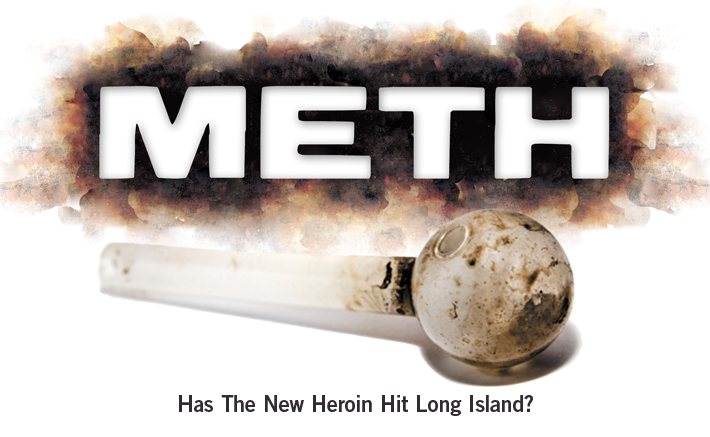

Methamphetamine and a used glass pipe (left) seized by the DEA. In 1999, two meth labs were reported in New York, both of them located upstate. In 2010, that number jumped to 31 and included labs in dense residential areas of New York City and Long Island. Areas where meth labs have been seized in Nassau and Suffolk Counties include Farmingville, Patchogue, Brentwood, Ridge and East Hampton. There is currently no comprehensive list of homes and buildings once used to produce meth. (Photos: DEA)
RISKY BEHAVIOR
A California mother was convicted of stabbing her newborn baby to death in January. In 2010, an Oklahoma mother drowned her child in a washing machine, a New Mexico woman claiming to be god stabbed her son in the neck with a screwdriver, and a 23-year-old Fresno, Calif., woman fatally shot her two toddlers and a cousin, critically wounded her husband and then killed herself. These are only a handful of the accounts of violence attributed to meth use.
“Most of the drugs out there don’t readily prompt psychosis or psychotic symptoms—meth does,” says Reynolds. “As serious as heroin is, people don’t take heroin and jump off buildings, but people take meth and do all sorts of things they wouldn’t otherwise do—and the level of addiction tends to progress very quickly.”
New studies conducted at Brookhaven Laboratory in Upton show that meth, which is known to cause intense paranoia, feelings of invincibility, visual and auditory hallucinations, in addition to aggressive and violent behavior, actually alters the chemistry of the brain, causing schizophrenia-like psychosis that continues long after the user stops using.
The study of meth’s effects on the brain was the first of its kind, and explains why the drug is so highly addictive.
“Methamphetamine is one of the most addictive and neurotoxic drugs of abuse,” says Brookhaven chemist Joanna Fowler, lead author on the study. “It produces large increases in dopamine, a brain chemical associated with feelings of pleasure and reward—both by increasing dopamine’s release from nerve cells and by blocking its re-uptake.”
Like cocaine, the study showed that meth entered the brain quickly, but it stayed there much longer.
And while cocaine remained concentrated in only the reward center of the brain, meth was concentrated all over the brain.
“This slow clearance of methamphetamine from such widespread brain regions may help explain why the drug has such long-lasting behavioral and neurotoxic effects,” Fowler says. “Meth is known to produce lasting damage.”
That damage includes extensive physical deterioration. The “Faces of Meth,” a campaign that has gone viral on the Internet, is a series of mug shots of meth users compiled by the Multnomah County Sheriff’s Office in Oregon which show once vibrant people at the beginning of their addiction and—less than a year later, in some cases—they look like zombies, with rotted teeth and collapsed jaws commonly referred to as “meth mouth,” severely aged and wrinkled skin, and festering sores covering their faces due to compulsive picking at imaginary “meth bugs” that users perceive on their skin.
Meth use has also led to a major health crisis in the gay community. Recent reports by the National Drug Intelligence Center show rave attendees are abusing meth at an increasing rate.
Over the past decade, crystal meth, or “Tina,” has been used as a sex drug commonly found at raves in the community and has been blamed for spreading HIV among users.
“I’m a sex addict when I’m on crystal,” says one participant in Dynamics of Methamphetamine Markets in NYC, a 2011 study of 132 men in the NYC party scene who used crystal meth. “My morals go out the window. It’s a must-have thing. You have sex with people, with people you wouldn’t normally have sex with.”
A series of campaigns targeting the club scene have since been launched, including the Long Island GLBT Community Center’s Crystal Meth Project, aimed at providing education, support, information and referrals to gay and bisexual men on LI who are at risk for or living with meth addiction. But meth is not merely a sex drug. Its use has also increased among teens looking for a new way to get high.
According to the CDC’s NY High School Youth Risk Behavior Survey in 2009, 4.8 percent—or 14,288—of teens said they had used methamphetamines one or more times as an alternative to other drugs. Heroin use, which reached epidemic proportions on LI that same year, came in at 3.8 percent.
“[Methamphetamine] lasts longer and you don’t have to spend so much money,” said another participant in the study. “The [immediate] rush lasts for 20 minutes; [the overall high] lasts longer. It’s a better high. Nowadays, the crack is garbage.”
And for those making it themselves, all it took—until recently—was a trip to the local supermarket.




